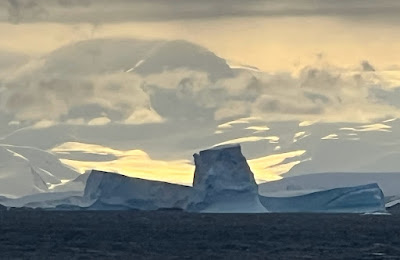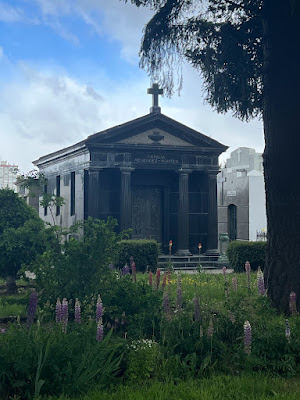 |
| The seventh one is checked off! |
We did it! We’ve now visited all seven continents. There have been so many amazing experiences along the way. Some of them are easy to describe, others difficult to describe, and a few that are downright impossible to put into words. Antartica falls into the impossible to describe category.
Size wise Antartica is huge. It’s larger than the contiguous United States. According to what we’ve learned from the Antartica experts on board, 61% of the world’s fresh water can be found in Antartica….as ice. Ironically Antartica is considered a desert. The accumulation of ice and snow has been millions of years in the making.
Antarctica is the only continent without a human population Thanks to some forward thinking people the Antarctica Treaty Alliance was signed on December 1, 1959. The treaty was signed by twelve countries (including the US), to protect and preserve the fragile and important ecosystem. The treaty provides oversight for all activities in Antarctica. Scientific research projects must be approved and tourism is very limited. From the limited research I did on the treaty it appears to be working extremely well, and is a model of international cooperation for the benefit of everyone. Hopefully it continues!
From Cape Horn we cruised southward across the Drake Passage for two days. We felt very fortunate that we had the “Drake Lake” both days…….smooth water and dropping temperatures as we made our way. We’ve seen icebergs on other adventures, but we quickly realized that there are icebergs and then there are Antartica icebergs. It wasn’t unusual to pass between two icebergs that appeared to be much larger than the ship. We did learn that no matter the size of the iceberg, only around 10% is visible. We didn’t see it, but we were told that the largest iceberg out there is A23A and that it is currently 4 times the size of New York City. Thankfully we have on board skilled ice pilots who along with our very personable captain kept us from turning into the Titanic.
 |
| The Cape Horn Lighthouse. A family of four and a cat live there. Their nearest neighbors are a few hundred miles away! |
 |
| One of many Albatrosses that entertained us around Cape Horn. |
 |
| One of the first iceberg sightings as we traveled south across the Drake Passage. Note the lake conditions. There are no pictures of the “Drake Shake” conditions because the outside decks were closed. |
Our cruise took us to the Antarctic Peninsula, which with a little imagination looks somewhat like Florida jutting out. We had four wonderful days cruising in and out of bays and channels, as well as getting close up looks of both Deception and Elephant Islands. All the while we were marveling at the scenery and enjoying watching hundreds of thousands of penguins swimming along beside the ship and standing guard over their babies on the rocky shore line. We also had a daily dose of whales, sea lions, Antarctic birds and snow.
The weather was about as cooperative as the weather can be in that part of the world. The skies were mostly overcast with the temperatures ranging from the single digits to the upper twenties. It was never intolerable when we were outside, especially since we were never more than a few steps away from being out of the wind and weather and back in the cozy confines of the Oosterdam. Sunset was close to midnight and sunrise around 4 am, but it never really got completely dark.
It really is impossible to describe Antartica with words. Pictures capture just a glimpse of how spectacular this frozen continent really is. Below are some of our favorites. I’ve captioned some with specific points of interest……enjoy!
 |
| Approaching the Antartica Peninsula! |
 |
| The Palmer Research Station. It’s one of the US Research Stations. In the summer it is staffed by around 60 people. During the winter it is staffed by around 30 people. |
 |
| The dark line leading to the water is the penguin trail. There are a few penguins near the water’s edge. |
 |
| The great majority of the coastline around Antarctica is classified as “glacier”. |
 |
| A future iceberg calving off the glacier. |
 |
| The two things that look like logs are actually humpback whales. |
 |
| Iceberg with a built-in swimming pool. We had seen one earlier that had a seal frolicking around inside. |
 |
| Morning Tai Chi by the indoor pool |
 |
| Penguins on the slope! |
 |
| Penguins on the Rocks! |
 |
Penguins chilling on ice!
|
 |
| Polar plunge in the outdoor pool. No! We did not participate! |
 |
| We didn't earn the Polar Plunge Certificate. However, we were inducted into The Order of the Moss Back for rounding Cape Horn and The Order of the Red Nose for traveling to Antartica. I'm not sure what benefits come with being inducted other than these spiffy certificates. |
 |
| Elephant Island. It was so named because the island resembles the head of an elephant. It was here that 22 men spent four months after their ship was destroyed by an ice pack. They survived under lifeboats, eating penguins and seals. True to his word, the expedition leader (Ernest Shackleton). who left to seek help did come back to rescue them. The small thing sticking up in the lower middle of the picture is a monument to the rescue. |
 |
Penguin covered rocks at Elephant Island.
|






















































